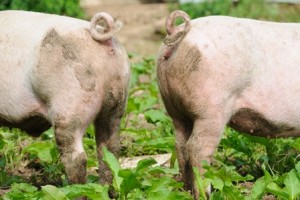Pig Diseases
Coccidiosis in Pigs
Also known as: Eimeria

Coccidiosis in piglets can occur in any management system. The source of infection is assumed to be from oocysts shed by sows in feces.
Coccidiosis is a common cause of piglet diarrhea, accounting for up to 27% cases of diarrhea between 7 days of age and weaning (Cowart and Casteel, 2001), causing scour in piglets before weaning and sometimes immediately post-weaning (Straw et al., 2013). Infection can occur in all types of farrowing facilities and under all types of management systems (Taylor et al., 2007)
Causes of Coccidiosis in Pigs
The most common cause of coccidiosis is Isospora suis which belongs to the Eimeriidae family of protozoa (Straw et al, 2013; Potter, 1998). It is found mainly in pre-weaning piglets, and spread by piglet-to-piglet contact (Cowart, 1995). Incidence of the disease in the UK is not known, but I. suis is present in herds countrywide (Roberts and Walker, 1981; Taylor, 1995). Eimeria debliecki, Eimeria polita, Eimeria scabra and Eimeria Spinosa have all been described in causing clinical disease in pigs (Taylor et al., 2007). Several Eimera spp species have been identified to cause disease in different hosts (Cattle, lambs, poultry), however they are host-specific, i.e., they only infect one species.
Clinical Signs of Coccidiosis in Pigs
Coccidial infection most commonly results in yellow or creamy-grey diarrhea, causing loss of condition and reduced growth rates in piglets 7-10 days of age. Severely affected piglets produce a rough haired coat, become dehydrated and remain continually dirtied with feces (Straw et al., 2013). Failure to respond to standard antimicrobial scours therapy may indicate coccidial infection. Mortality rates may reach 20% (Taylor, 1995). Concurrent infections with other bacteria, viruses or parasites can increase mortality further.
I. suis can cause infections on its own or in combinations with other enteropathogens. Links to other causes of piglet diarrhea covered in this website are:
- Clostridial diseases
- E. coli
- Scours
- Salmonellosis
- Transmissible gastroenteritis (TGE)
Control and Prevention of Coccidiosis in Pigs
A good level of hygiene in farrowing accommodation is necessary to minimize the spread of infection, and bedding should be destroyed and huts moved between litters. Disinfection can be used although available disinfectants are not particularly effective in combating I. suis, emphasizing the need for physical cleaning and burning of bedding (Stuart et al., 1981). Your veterinarian can provide advice on agents to combat the oocysts.
In outdoor units, the problem is more pronounced in the summer, and may be aggravated by wallowing, where sows’ udders become contaminated with coccidial oocysts (Potter, 1998). Rodents also represent a potential means of spreading infection, and should be controlled (Straw et al., 2013).
Increased risk is associated with cross fostering piglets within 24 hours of birth (Skampardonis et al., 2012).
Treating Coccidiosis in Pigs
Coccidial infection does not respond to antimicrobials (Roberts and Walker, 1981; Taylor, 1995) or treatment via sows as they are not a major source of infection (Straw et al., 2013).
Toltrazuril is regularly used in herds to individually treat affected piglets by mouth at 3-5 days of age. Affected litters also respond well to water by mouth and should be given access to drinking facilities – for example by placing a cube drinker in the fender of the farrowing hut.
Any drug therapy should be supported with provision of dry bedding and reduction of stress from inclement weather, overcrowding or unhygienic conditions. Treatment should be discussed with a veterinarian.
Coccidiosis in Pigs and Welfare
Every effort should be made to give supportive treatment to affected animals and to improve husbandry and hygiene in order to reduce disease occurrence.
Good Practice Based on Current Knowledge
- Disinfect accommodation between litters
- Remove or burn bedding after each litter
- Move farrowing paddocks after each litter
- Keep rodent population under control
- Give affected litters access to drinking water
- If a problem exists, utilise an oral anticoccidial product
If coccidiosis or unidentified piglet scour has been a continuous problem on the farm, the husbandry factors associated with the condition should be identified and appropriate improvements should be introduced.


 British English
British English

Comments are closed.